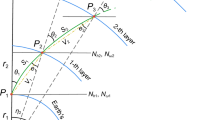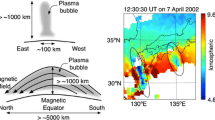Abstract
Ground-based augmentation system (GBAS) is a safety of life system that supports precision approach, landing, departure and surface operations in civil aviation. To compensate the tropospheric delay difference encountered at the aircraft and ground stations, empirical tropospheric correction (TC) models are applied. Scale height is one of the key parameters in TC models, while there are various methods to estimate scale heights and their performance is not fully evaluated, which affects the integrity and poses threats to GBAS. The purpose of this study is to evaluate the performance of TC models when using different scale height estimation methods by exploiting analytical products, including the European center for medium-range weather forecasts and meteorological data from the stations deployed in the crustal movement observation network of China in 2021. Taking the effects of virtual temperature and station height anomaly into consideration, a modified ray-tracing algorithm is proposed to calculate the tropospheric delay error, which is the difference of tropospheric delay between that encountered, respectively, at the GBAS station and the aircraft. The calculated tropospheric delay error serves as a reference to evaluate the performance of TC models. Results show that the TC model bias in the zenith direction estimated by the different scale height methods is approximately equal in the GBAS approach service type C. When the elevation is lower than 20°, there is a significant bias induced by the mapping function of TC models. Additionally, the TC model bias increases with height for GBAS precision approach service. The maximum TC model bias in the zenith direction at most stations exceeds 20 mm. The occurrence probability of anomaly with TC model bias more than 10 mm with a higher than 20% at a height of 400 m. This study contributes to better understanding of the GBAS TC model performance in China. It provides valuable insights and guidance for developing more precise TC models.
















Similar content being viewed by others
Data availability
ERA5 and meteorological datasets were obtained from https://cds.climate.copernicus.eu/ and https://data.earthquake.cn/, respectively.
References
Askne J, Nordius H (1987) Estimation of tropospheric delay for microwaves from surface weather data. Radio Sci 22(3):379–386. https://doi.org/10.1029/RS022i003p00379
Born M, Wolf E (1999) Principles of optics, 7th edn. Cambridge University Press, New York
Chao CC (1974) The tropospheric calibration model for Mariner Mars 1971. NASA Technical Report 32-1587. National Aeronautics and Space Administration. https://ntrs.nasa.gov/api/citations/19740008866/downloads/19740008866.pdf. Accessed 6 June 2023
Davis JL, Herring TA, Shapiro II, Rogers AEE, Elgered G (1985) Geodesy by radio interferometry: effects of atmospheric modeling errors on estimates of baseline length. Radio Sci 20(6):1593–1607. https://doi.org/10.1029/RS020i006p01593
Haji Aghajany S, Amerian Y (2017) Three dimensional ray tracing technique for tropospheric water vapor tomography using GPS measurements. J Atmos Solar Terr Phys 164:81–88. https://doi.org/10.1016/j.jastp.2017.08.003
Hobiger T, Ichikawa R, Koyama Y, Kondo T (2008) Fast and accurate ray-tracing algorithms for real-time space geodetic applications using numerical weather models. J Geophys Res 113:D20302. https://doi.org/10.1029/2008JD010503
Hobiger T, Kinoshita Y, Shimizu S, Ichikawa R, Furuya M, Kondo T, Koyama Y (2010) On the importance of accurately ray-traced troposphere corrections for interferometric SAR data. J Geod 84(9):537–546. https://doi.org/10.1007/s00190-010-0393-3
Hofmeister A, Böhm J (2017) Application of ray-traced tropospheric slant delays to geodetic VLBI analysis. J Geod 91(8):945–964. https://doi.org/10.1007/s00190-017-1000-7
Hopfield HS (1971) Tropospheric effect on electromagnetically measured range: prediction from surface weather data. Radio Sci 6(3):357–367. https://doi.org/10.1029/RS006i003p00357
Khanafseh S, Von Engeln A, Pervan B (2016) Tropospheric duct anomaly threat model for high integrity and high accuracy navigation. In: Proceedings ION GNSS+ 2016, Institute of Navigation, Portland, Oregon, USA, September 12–16, pp 1609–1616. https://doi.org/10.33012/2016.14662
Leandro R, Santos M, Langley RB (2006) UNB neutral atmosphere models: development and performance. In: Proceedings ION NTM 2006, Institute of Navigation, Monterey, CA, USA, January 18–20, pp 564–573
McCarthy DD, Petit G (2004) IERS conventions 2003. IERS technical note 32, Verlag des Bundesamts für Kartographie und Geodäsie, Frankdfurt am Main
McGraw GA, Murphy T, Brenner M, Pullen S, Van Dierendonck AJ (2000) Development of the LAAS accuracy models. In: Proceedings ION GPS 2000, Institute of Navigation, Salt Lake City, UT, USA, September 19–22, pp 1212–1223
McGraw GA (2012) Tropospheric error modeling for high integrity airborne GNSS navigation. In: Proceedings IEEE/ION PLANS 2012, Institute of Navigation, Myrtle Beach, South Carolina, USA, April 24–26, pp 158–166
Nafisi V, Urquhart L, Santos MC, Nievinski FG, Bohm J, Wijaya DD, Schuh H, Ardalan AA, Hobiger T, Ichikawa R, Zus F, Wickert J, Gegout P (2012) Comparison of ray-tracing packages for troposphere delays. IEEE Trans Geosci Remote Sens 50(2):469–481. https://doi.org/10.1109/TGRS.2011.2160952
Peng S (2020) 1-km monthly precipitation dataset for China (1901–2022). Big Earth Data Platform Three Poles. https://doi.org/10.5281/zenodo.3185722
RTCA (2004) Minimum aviation system performance standards for the local area augmentation system (LAAS). Tech Rep DO-245A, RTCA, Washington DC
RTCA (2017) Minimum operational performance standards for GPS local area augmentation system airborne equipment. Tech Rep DO-253D, RTCA, Washington DC
Saito S, Sunda S, Lee J, Pullen S, Supriadi S, Yoshihara T, Terkildsen M, Lecat F (2017) Ionospheric delay gradient model for GBAS in the Asia-Pacific region. GPS Solut 21(4):1937–1947. https://doi.org/10.1007/s10291-017-0662-1
Saito S, Yoshihara T, McGraw G, Harris M (2021) Agenda Item 3: SARPs for GNSS elements and signals (GBAS), guidance on the tropospheric scale height. JWGs/7-WP/6, international civil aviation organization navigation systems panel
Saito S, Yoshihara T, McGraw G, Martinez G, Lavik L, Topland M (2022) Agenda Item 3: SARPs for GNSS elements and signals (GBAS), validation and proposals of the guidance on the tropospheric parameters for GBAS. JWGs/9-WP/25, international civil aviation organization navigation systems panel
Sayim I (2003) Ranging error overbounds for navigation integrity of local area augmented GPS. Dissertation, Illinois Institute of Technology
Sheng PX, Mao JT, Li JG, Ge ZM, Zhang AC, Sang JG, Pan NX, Zhang HS (2013) Atmosphere physics, 2nd edn. Peking University Press, Beijing
Shi H, Zhang R, Nie Z, Li Y, Chen Z, Wang T (2018) Research on variety characteristics of mainland China troposphere based on CMONOC. Geodesy Geodyn 9(5):411–417. https://doi.org/10.1016/j.geog.2018.06.00
Skidmore TA, van Graas F (2004) An investigation of tropospheric errors on differential GNSS accuracy and integrity. In: Proceedings ION GNSS 2004, Institute of Navigation, Long Beach, CA, USA, September 21–24, pp 2752–2760
Song Y, Achberger C, Linderholm HW (2011) Rain-season trends in precipitation and their effect in different climate regions of China during 1961–2008. Environ Res Lett 6(3):034025. https://doi.org/10.1088/1748-9326/6/3/034025
Thayer GD (1967) A Rapid and Accurate Ray Tracing Algorithm for a Horizontally Stratified Atmosphere. Radio Sci 2(2):249–252. https://doi.org/10.1002/rds196722249
Thayer GD (1974) An improved equation for the radio refractive index of air. Radio Sci 9(10):803–807. https://doi.org/10.1029/RS009i010p00803
Wallace JM, Hobbs PV (2006) Atmospheric thermodynamics. Atmospheric science: an introductory survey, vol 3, 2nd edn. Academic Press, pp 63–111
Wang J, Balidakis K, Zus F, Chang X, Ge M, Heinkelmann R, Schuh H (2022) Improving the vertical modeling of tropospheric delay. Geophys Res Lett 49(5):e2021GL096732. https://doi.org/10.1029/2021GL096732
Warburton J (2010) Tropospheric error bounding: nominal and anomalous tropospheric conditions parameter calculation and consistency. Federal Aviation Administration. https://laas.tc.faa.gov/documents/CAAC/CAAC%2011%20Tropospheric%20Threat.pdf. Accessed 6 June 2023
Zhang M, Zhang K, Wu S, Shi J, Li L, Wu H, Liu S (2022) A new method for tropospheric tomography using GNSS and Fengyun-4A data. Atmos Res 280:106460. https://doi.org/10.1016/j.atmosres.2022.106460
Zhou Y, Lou Y, Zhang W, Kuang C, Liu W, Bai J (2020) Improved performance of ERA5 in global tropospheric delay retrieval. J Geod 94(10):103. https://doi.org/10.1007/s00190-020-01422-3
Acknowledgements
The authors would like to thank the researchers and engineers at the National Key Laboratory of CNS/ATM for their advices and interests. The work was carried out with the financial support from the National Key Research and Development Program of China (grant nos. 2020YFB0505603), the National Natural Science Foundation of China (grant nos. 62022012, 62101019, U2033215 and U2233217), the Civil Aviation Security Capacity Building Fund Project (grant nos. CAAC Contract 2020(123), CAAC Contract 2021(77) and CAAC Contract 2022(110)).
Author information
Authors and Affiliations
Contributions
YZ and HT initiated the study. HT and KG wrote the manuscript with support from ZW. SW and YW helped to collect data and provided some helpful suggestions. All authors provided critical feedbacks and approved the manuscript.
Corresponding author
Ethics declarations
Conflict of interest
The authors declare that they have no competing interests.
Additional information
Publisher's Note
Springer Nature remains neutral with regard to jurisdictional claims in published maps and institutional affiliations.
Rights and permissions
Springer Nature or its licensor (e.g. a society or other partner) holds exclusive rights to this article under a publishing agreement with the author(s) or other rightsholder(s); author self-archiving of the accepted manuscript version of this article is solely governed by the terms of such publishing agreement and applicable law.
About this article
Cite this article
Zhu, Y., Tang, H., Wang, Z. et al. Performance evaluation of tropospheric correction model for GBAS in China. GPS Solut 28, 109 (2024). https://doi.org/10.1007/s10291-024-01646-2
Received:
Accepted:
Published:
DOI: https://doi.org/10.1007/s10291-024-01646-2




